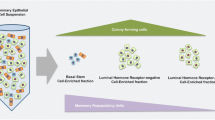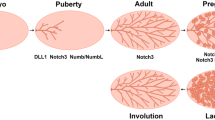Abstract
HGF/SF is a multifunctional cytokine whichthrough binding to its cellular receptor, c-MET, canelicit mitogenic, morphogenic and motogenic responses intarget cells. Expression of HGF/SF and c-MET has been shown to be critical in earlyembryogenesis affecting development of many organs andtissues. The effects of HGF/SF4 on established human andmouse mammary cell lines have previously been reported. This review describes the source and targetsfor HGF/SF in both human and mouse mammary tissue anddiscusses the effects of HGF/SF on primary mouse andhuman mammary epithelial cells in vitro, detailing the individual response of the two epithelialsub-population of cells which comprise this organ.Additionally, the effects of HGF/SF overexpression onmouse mammary gland development in vivo, aresummarized.
Similar content being viewed by others
REFERENCES
C. Grobstein (1967). Mechanism of organogenetic tissue interaction. Natl. Cancer Inst. Monogr. 26:279–299.
T. M. Jessel and D. A. Melton (1992). Diffusable factors in vertebrate embryonic development. Cell 68:257–270.
P. M. Sharp and W. J. Ferguson (1988). Mesenchymal influences on epithelial differentiation in developing systems. J. Cell Sci. Suppl. 10:195–230.
C. W. Daniel and G. B. Silberstein (1987). Postnatal development of rodent mammary gland. In M.C. Neville and C.W. Daniel (eds.), The Mammary Gland: Development, Regulation and Function, Plenum Press, New York, pp. 3–36.
S. Coleman, G.B. Silberstein, and C. W. Daniel (1988). Ductual morphogenesis in the mouse mammary gland: Evidence supporting a role for epidermal growth factor. Dev. Biol. 127:304–315.
R. Anbazhagan, J. Bartek, P. Monaghan and B. A. Gusterson (1991). Growth and development of the human infant breast. Am. J. Anat. 192:407–417.
Y. J. Topper and C. S. Freeman (1980). Multiple hormone interactions in the developmental biology of the mammary gland. Physiol. Rev. 60:1049–1106.
R. C. Humphreys, M. Krajewska, S. Krnacik, R. Jaeger, H. Weiher, S. Krajewski, J. C. Reed, and J. M. Rosen (1996). Apoptosis in the terminal endbud of the murine mammary gland: A mechanism od ductal morphogenesis. Development 122:4013–4022.
Y. Hirai, A. Lochter, S. Galosy, S. Koshida, S. Niwa, and M. J. Bissell (1998). Epimorphin functions as a key morphoregulator for mammary epithelial cells. J. Cell Biol. 140:159–169.
Y. E. Yang, D. Spitzer, M. Meyer, C. Sachs, C. Niemann, G. Hartmann, K. M. Weidner, C. Birchmeier, and W. Birchmeier (1995). Sequential requirement of hepatocyte growth factor and neuregulin in the morphogenesis and differentiation of mammary gland. J. Cell Biol. 131:215–226.
S. D. Robinson, G. B. Silbertstein, A. B. Roberts, L. C. Flanders, and C. W. Daniel (1991). Regulated expression and growth inhibitory effects of transforming growth factor β isoforms in mouse mammary gland development. Development 113:867–878.
S. M. Snedeker, C. F. Brown, and R. P. DiAugustine (1991). Expression and functional properties of transforming growth factor a and epidermal growth factor during mouse mammary gland ductal morphogenesis. Proc. Natl. Acad. Sci. U.S.A. 88:276–280.
M. Weil, A. Itin, and E. Keshet (1995). A role for mesenchyme-derived tachykinins in tooth and mammary gland morphogenesis. Development 121:2419–2428.
S. Coleman-Krnacik and J. M. Rosen (1994). Differential temporal and spatial gene expression of fibroblast growth factor family members during mouse mammary gland development. Mol. Endocrinol. 8:218–229.
B. Niranjan, L. Buluwela, J. Yant, N. Perusinghe, A. Atherton, D. Phippard, T. Dale, B. Gusterson, and T. Kamalati (1995). HGF/SF: A potent cytokine for mammary growth, morphogenesis and development. Development 121:2897–2908.
S. J. Weber-Hall, D. J. Phippard, C. C. Niemeyer, and T. Dale (1994). Developmental and hormonal regulation of Wnt gene expression in the mouse mammary gland. Differentiation 57:205–214.
G. W. Robinson and L. Hennighausen (1997). Inhibins and activins regulate mammary epithelia cell differentiation through mesenchymal-epithelial interactions. Development 124: 2701–2708.
E. Gherardi and M. Stoker (1991). Hepatocyte growth factor-Scatter factor: Mitogen, motogen and met. Cancer Cells 3:227–232.
F. Bussolino, M. F. Di Renzo, M. Ziche, E. Bocchietto, M. Olivero, L. Naldini, G. Gaudino, L. Tamagnone, A. Coffer, and P. M. Comoglio (1992). Hepatocyte growth factor is a potent angiogenic factor which stimulates endothelial cell motility and growth. J. Cell Biol. 119:629–641.
R. Montesano, G. Schaller, and L. Orci (1991). Induction of epithelial tubular morphogenesis in vitro by fibroblast derived soluble factors. Cell 66:697–711.
K. Higashio, N. Shima, M. Goto, Y. Itagaki, M. Nagao, H. Yasuda, and T. Morinaga (1990). Identity of a tumor cytotoxic factor from human fibroblasts and hepatocyte growth factor. Biochem. Biophys. Res. Comm. 170:397–404.
H. Tajima, K. Matsumoto, and T. Nakamura (1991). Hepatocyte growth factor has potent anti-proliferative activity in various tumor cell lines. Fed. Euro. Biochem. Soc. Lett. 291:229–232.
G. Shiota, D. B. Rhoads, T. C. Wang, T. Nakamura, and E. V. Schmidt (1992). Hepatocyte growth factor inhibits growth of hepatocellular carcinoma cells. Proc. Natl. Acad. Sci. U.S.A. 89:373–377.
L. Naldini, K. M. Weidner, E. Vigna, G. Gaudino, A. Bardeli, C. Ponzetto, R. P. Narsimhan, G. Hartmann, R. Zarnegar, G. K. Michalopoulos, W. Bichmeier, and P. M. Comoglio (1991). Scatter factor and hepatocyte growth factor are indistinguishable ligands for the MET receptor. EMBO J. 10:2867–2878.
D. P. Bottaro, J. S. Rubin, D. L. Faletto, A. M-L. Chan, T. E. Kmiecik, G. F. Vande Woude, and S. A. Aaronson (1991). Identification of the hepatocyte growth factor receptor as the c-met proto-oncogene product. Science 251:802–804.
K. M. Weidner, M. Sachs, and W. Birchmeier (1993). The Met receptor tyrosine kinase transduces motility, proliferation, and morphogenic signals of scatter factor/hepatocyte growth factor in epithelial cells. J. Cell Biol. 121:145–154.
C. Ponzetto, A. Bardelli, Z. Zhen, F. Maina, P. Zonca, S. Giordano, A. Graziani, G. Panayotou, and P.M. Comoglio (1994). A multifunctional docking site mediates signaling and transformation by the hepatocyte growth factor/scatter factor receptor family. Cell 77:261–271.
C. Ponzetto, Z. Zhen, E. Audero, F. Maina, A. Bardelli, M. L. Basile, S. Giordano, R. Narsimhan and P. Comoglio (1994). Specific uncoupling of GRB2 from the Met receptor. J. Biol. Chem. 271:14119–14123.
G. Pelicci (1995). The motogenic and mitogenic responses to HGF are amplified by the Shc adaptor protein. Oncogene 10:1631–1638.
K. M. Weidner, S. DiCesare, M. Sachs, V. Brinkmann, J. Behrens, and W. Birchmeier (1996). Interaction between Gabl and the c-Met receptor tyrosine kinase is responsible for epithelial morphogenesis. Nature 384:173–176.
I. Royal, T. M. Fournier, and M. Park (1997). Differential requirement for Grb2 and PI3–Kinase in HGF/SF-induced cell motility and tubulogenesis. J. Cell Physiol. 173:196–201.
A. J. Ridley, P. M. Comoglio, and A. Hall (1995). Regulation of scatter factor/hepatocyte growth factor responses by Ras, Rac, and Rho in MDCK cells. Mol. Cell. Biol. 15:1110–1122.
C. Boccaccio, M. Ando, L. Tamagnone, A. Bardelli, P. Michieli, C. Battistini, and P. M. Comoglio (1998). Induction of epithelial tubules by growth factor HGF depends on the STAT pathway. Nature 391:285–288.
M. Kretzschmar, J. Doody, and J. Massague (1997). Opposing BMP and EGF signalling pathways converge on the TGF-β family mediator Smadl. Nature 389:618–622.
M. Stoker, E. Gherardi, M. Perryman, and J. Gray (1987). Scatter factor is a fibroblast derived modulator of epithelial cell motility. Nature 327:239–242.
E. Andermarcher, M. A. Surani, and E. Gherardi (1996). Co-expression of the HGF/SF and c-met genes during early mouse embryogenesis precedes reciprocal expression in adjacent tissues during organogenesis. Dev. Genetics 18:254–266.
D. Sonnenberg, D. Meyer, K. M. Weidner, and C. Birchmeir (1993). Scatter factor/Hepatocyte growth factor and its receptor, the c-met tyrosine kinase, can mediate a signal exchange between mesenchyme and epithelia during mouse development. J. Cell Biol. 123:223–235.
C. Schmidt, F. Bladt, S. Goedecke, V. Brinkmann, W. Zschiesche, M. Sharpe, E. Gherardi, and C. Birchmeier (1995). Scatter factor/hepatocyte growth factor is essential for liver development. Nature 373:699–702.
Y. Uehara, O. Minowa, C. Mori, K. Shiota, J. Kuno, T. Noda, and N. Kitamura (1995). Placental defect and embryonic lethality in mice lacking hepatocyte growth factor/scatter factor. Nature 373:702–705.
F. Bladt, D. Riethmacher, S. Isenmann, A. Aguzzi, and C. Birchmeier (1995). Essential role for c-met receptor in the migration of myogenic precursor cells into the limb bud. Nature 376:768–771.
S. Aoki, K. Takahashi, K. Matsumoto, and T. Nakamura (1997). Activation of Met tyrosine kinase by hepatocyte growth factor is essential for internal organogenesis in Xenopus embryo. Biochem. Biophys. Res. Comm. 234:8–14.
H. Ohmichi, U. Koshimizu, K. Matsumoto, and T. Nakamura (1998). Hepatocyte growth factor (HGF) acts as a mesenchyme-derived morphogenic factor during fetal lung development. Development 125:1315–1324.
O. F. Santos, E. J. Barros, X. M. Yang, K. Matsumoto, T. Nakamura, M. Park, and S. K. Nigam (1994). Involvement of hepatocyte growth factor in kidney development. Dev. Biol. 163:525–529.
A. S. Woolf, M. Kolatsi-Joannou, P. Hardman, E. Andermarcher, C. Moorby, L. G. Fine, P.S. Jat, M. D. Nobel, and E. Gherardi (1995). Roles of hepatocyte growth factor/scatter factor and the met receptor in the early development of metanephros. J. Cell Biol. 128:171–184.
M. S. Pepper, J. Y. Soriano, P. A. Menoud, A. P. Sappino, L. Orci, and R. Montesano (1995). Modulation of hepatocyte growth factor and c-met in the rat mammary gland during pregnancy, lactation, and involution. Exp. Cell Res. 219:204–210.
F. Stewart (1996). Role of epithelial-mesenchymal interactions and hepatocyte growth factor-scatter factor (HGF/SF) in placental development. Rev. Reprod. 1:144–148.
M. J. Tabata, K. Kim, J. G. Liu, K. Yamashita, T. Matsumura, J. Kato, M. Iwamoto, S. Wakisaka, K. Matsumoto, T. Nakamura, M. Kumegawa and K. Kurisu (1996). Hepatocyte growth factor is involved in the morphogenesis of tooth germ in murine molars. Development 122:1243–1245.
A. Ebens, K. Brose, E. D. Leonardo, M. G. Hanson, Jr., F. Bladt, C. Birchmeier, B. A. Barres, and M. Tessier-Lavigne (1996). Hepatocyte growth factor/scatter factor is an axonal chemoattractant and a neurotrophic factor for spinal motor neurons. Neuron 17:1157–1172.
Y. Yamamoto, J. Livet, R. A. Pollock, A. Garces, O. deLapeyriere, and C. E. Henerson (1997). Hepatocyte growth factor (HGF/SF) is a muscle derived survival factor for a subpopulation of embryonic motor neurons. Development 124: 2903–2913.
T. Takebayashi, M. Iwamoto, A. Jikko, T. Matsumura, M. Enomoto-Iwamoto, F. Myoukai, E. Koyama, T. Yamaai, K. Matsumoto, T. Nakamura, K. Kurisu, and S. Nuji (1995). Hepatocyte growth factor/scatter factor modulates cell motility, proliferation, and proteoglycan synthesis of chondrocytes. J. Cell Biol. 129:1411–1419.
J. V. Soriano, M. S. Pepper, T. Nakamura, L. Orci, and R. Montesano (1995). Hepatocyte growth factor stimulates extensive development of branching duct-like structures by cloned mammary gland epithelial cells. J. Cell Sci. 108:413–430.
F. Berdichevsky, D. Alfored, B. D'Souza, and J. Taylor-Papadimitriou (1994). Branching morphogenesis of human mammary epithelial cells in collagen gels. J. Cell Sci. 107:3557–3568.
H. Takayama, W. J. LaRochelle, R. Sharp, T. Otsuka, P. Kriebel, M. Anver, S. A. Aaronson, and G. Merlino (1997). Diverse tumorigenesis associated with aberrant development in mice overexpressing hepatocyte growth factor/scatter factor. Proc. Natl. Acad. Sci. U.S.A. 94:701–706.
T. J. Liang, A. E. Reid, R, Xavier, R. D. Cardiff, and T. C. Wang (1996). Transgenic expression of tpr-met oncogene leads to development of mammary hyperplsia and tumors. J. Clin Invest. 97:2872–2877.
J. Yant, L. Buluwela, B. Niranjan, B. Gusterson, and T. Kamalati (1995). In vivo effects of hepatocyte growth factor/scatter factor on mouse mammary gland development. Exp. Cell Res. 241:476–481.
Rights and permissions
About this article
Cite this article
Kamalati, T., Niranjan, B., Yant, J. et al. HGF/SF in Mammary Epithelial Growth and Morphogenesis: In Vitro and In Vivo Models. J Mammary Gland Biol Neoplasia 4, 69–77 (1999). https://doi.org/10.1023/A:1018756620265
Issue Date:
DOI: https://doi.org/10.1023/A:1018756620265




